Add another dimension of viewing to winter's favorite deep sky object, the Great Nebula of Orion.
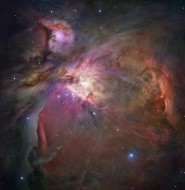
HST / NASA / ESA
The Orion Nebula is arguably the centerpiece of the winter sky. This bright, richly-detailed blossom of glowing gas and dust invites repeated observation. How many of us have pointed our telescope or binoculars in its direction five, six, or even ten times a season?
After the planets and Moon, it's the deep sky object to show family and friends, provided we can coax them into the cold.
Faintly visible with the naked eye and revealing a distinct shape in binoculars, a telescope lays bare the nebula's breathtaking whorls of nebulosity that unfurl from the brilliant Trapezium cluster blazing at its core.
Most sky objects appear pasted against a two-dimensional sky because human stereo vision can't sense depth over cosmic distances. Our eyeballs would have to be light years apart to accomplish that feat. But clues to the sky's hidden third dimension are out there. If you've ever watched one of Jupiter's moons cast its shadow on the planet's cloud tops, the sensation of depth is almost visceral.
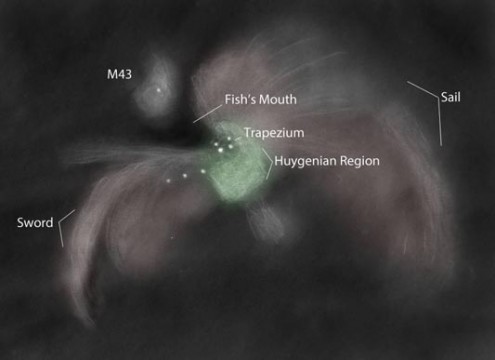
Bob King
With a little help, we can sense the depth in the Orion Nebula, too. The easiest place to begin is the thumb of dark nebulosity, nicknamed the Fish's Mouth, located between the bright multiple star, the Trapezium, and adjacent nebula M43 to the north. Through a small telescope the shadowy shape appears opaque, but a larger instrument clearly shows its mottled texture as light from bright nebulosity in the more distant background punches through.
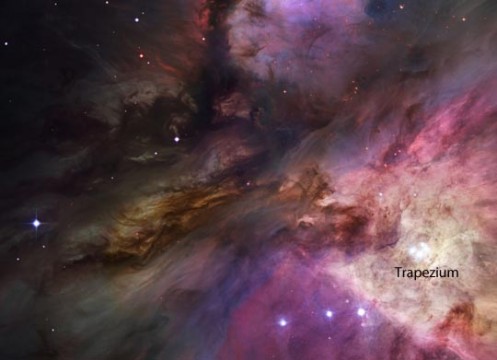
HST / NASA / ESA
The 3D effect is dramatic on a dark, moonless night using high magnification. The first time I tried this, I spent the next 20 minutes completely absorbed while visually thrashing through a dark forest of nebulosity I never knew existed. When seen in its entirety, the Fish's Mouth looks a lot more like a Dementor in the Harry Potter movies. Creepy, but utterly moving.
Studies of the structure of the Orion Nebula have shown that radiation pressure from the hot, young Trapezium stars has hollowed out the core of the nebula and literally "blown a hole" through the dust and gas, allowing us to peer inside the cloud to stare this clump of fresh-faced suns in the face.
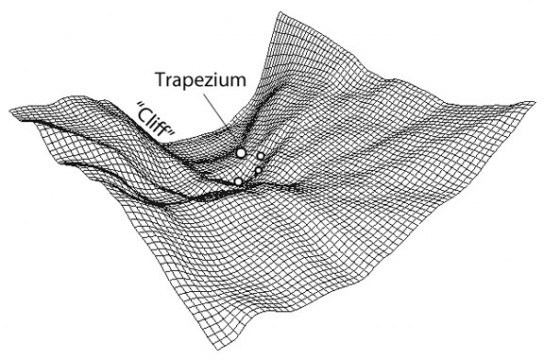
C.R. O'Dell and Zheng Wen with addition of Trapezium stars and annotations by the author
Using infrared and visible light observations from the Hubble Space Telescope and ground-based imagery, astrophysicists C.R. O'Dell and Zheng Wen (Rice University) created a 3D model of the inner surface of the hollowed out core of the nebula. Their model shows that the Trapezium stars hover above a wrinkled, shallow "valley" not far from a steep "cliff." Light from the stars ionizes the nebular gases and sets them aglow. According to research by O'Dell, the visible nebula we see is little more than a popped blister .08 light-years thick on the surface of the Orion Molecular Cloud, a vast complex of nebulae host to ongoing star formation.
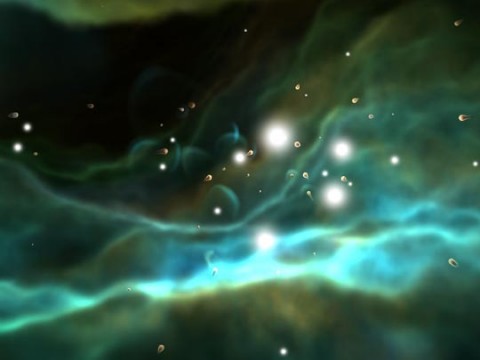
So what do we see when we put eye to eyepiece? The bright, green-hued Huygenian Region, named after the 17th century astronomer, Christian Huygens, who first studied it in detail, forms the valley's floor. The cliff is the bright bar-like feature southeast of the Trapezium.
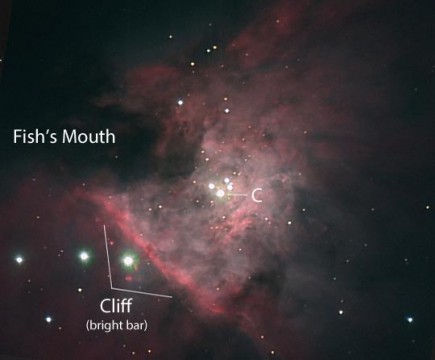
Patric Knoll
Wishing you happy travels to another dimension of one of the most beautiful objects in the night sky.
Want more nebulae? Let Sue French guide you to more Deep Sky Wonders!
 9
9
Comments
Anthony Barreiro
December 17, 2014 at 3:24 pm
Thanks Bob, this is fascinating. In terms of seeing nebulae in three dimensions, I had an aha moment when I learned to see a dark nebula as a cloud of dust and gas blocking the light from the stars and bright nebulae behind it, rather than simply as a blank dark area. This helps me understand what is closer and what is farther away, and provides the third dimension of depth.
You must be logged in to post a comment.
Bob KingPost Author
December 17, 2014 at 6:32 pm
Hi Anthony,
Thanks for writing and saying. I've had similar aha moments with other dark nebulae, but the Fish's Mouth is one of the best.
You must be logged in to post a comment.
December 19, 2014 at 4:50 pm
Best 3D View I've had of the Orion Nebula was with my 12" LX-200, and a Celestron BinocularViewer... high power.
Those old Celestron BinoViews were the best.
You must be logged in to post a comment.
John-Keeran
December 19, 2014 at 6:12 pm
A faux-stereo image can be produced with two shots of slightly different positions as seen here:
http://www.panoramio.com/photo/102217165
Using stellar parallax, each of two photos of the Great Orion Nebula from opposite sides of the Earth's orbit could be digitally enhanced to exaggerate the differences and create or more dramatic shift and stereo (3D) effect.
You must be logged in to post a comment.
chrfrde
December 20, 2014 at 9:14 am
The effect of parallax at this distance is tiny. For stars (relatively bright points of light) it is measurable using a dedicated space telescope, but stereo processing a pair of images seems unfeasible.
You must be logged in to post a comment.
December 19, 2014 at 7:14 pm
I have a binoscope made using dual Takahashi FS-102's, which is basically one of these fine telescope for each eye. The view of this nebula is awesome but I didn’t get the same sense about 3D positioning that you’ve described here. Now I have a clearer understanding of what I am seeing. Thanks for this insightful read.
You must be logged in to post a comment.
Bob KingPost Author
January 3, 2015 at 9:55 pm
You're welcome DougScho.
You must be logged in to post a comment.
allan-fix
December 24, 2014 at 3:17 am
First: thank you so much for your dedication and enthusiasm and this article in particular. Sense of wonder! Thanks..
Second: "Faintly visible with the naked eye and revealing a distinct shape in binoculars, a telescope...." You are saying the telescope is faintly visible. Look up "dangling participle."
thanks again.
You must be logged in to post a comment.
Bob KingPost Author
January 3, 2015 at 9:55 pm
Thanks allan-fix. Sorry for the dangle!
You must be logged in to post a comment.
You must be logged in to post a comment.